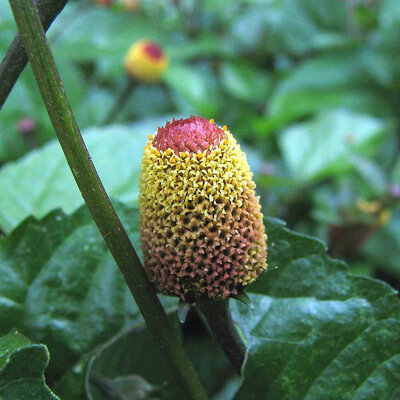
Spilanthes oleracea - Pará watercress
This wide-growing species has many bright yellow and red flowers on dark green foliage. Raw, the leaves and flowers have a surprising analgesic effect in the mouth. They can also be eaten cooked, like spinach.
Find out more on the Kokopelli blog: "The extremely medicinal qualities of Para cress".
These products may also be of interest to you
in bucket
Sow in trays, at a temperature of 18°C, 5 to 6 weeks before the last frosts. Transplant into cups after emergence. Sow with the root ball 30 cm apart in all directions, or sow directly in place. Thin out to 30 cm when plants have 3 or 4 leaves. Water regularly, especially in hot weather.
Pick leaves and flower buds as needed. Regular harvesting encourages new growth.
March, April, May
July, August, September, October
in the ground, in the greenhouse, in pot
semi-shade, sunny
fort
humus
wet, light
Spilanthes oleracea
mid-season
150 seeds
tender
Yellow
From 10 to 20 cm
round
West Indies
1883
"Vilmorin-Andrieux "Les Plantes Potagères
This plant is native to the West Indies and is mentioned in Vilmorin-Andrieux's 1883 book "Les Plantes Potagères".
Para cress, also known as "Bredy Mafana" or "Brède Mafane jaune", is native to South America. It has long been cultivated in the Mediterranean regions of Europe. It is widely consumed in tropical regions, and is the main ingredient in Madagascar's national dish, "romazava". Raw flowers and leaves have a surprisingly hot, pungent, peppery and refreshing taste. This plant, used as a vegetable and condiment, is in fact a medicinal plant renowned in many cultures around the world for its ability to relieve dozens of pathologies. Many preparations are currently available in the form of mother tinctures, extracts and so on. It is the aerial parts or roots that are used. In the United States alone, over thirty patents have been granted since 1976 on its medicinal properties. In traditional medicine, the Spilanthes genus has been used to treat throat pathologies: toothache, mouth ulcers, gingivitis, sore throats, headaches, rheumatism and muscular pains, fevers, colds and coughs, liver problems and intestinal problems: diarrhea, constipation, gastritis, jaundice, etc., viral, bacterial and fungal pathologies as well as tuberculosis and pneumonia, urinary problems and kidney stones, parasite problems. In some cultures, Spilanthes is also considered a fortifier and aphrodisiac. More recently, its antioxidant properties have been highlighted in the fight against cancer and other mutagenic influences. The 5 most biologically active groups with regard to its medicinal properties are terpenoids, flavonoids, coumarin, alkamides and polysaccharides.






